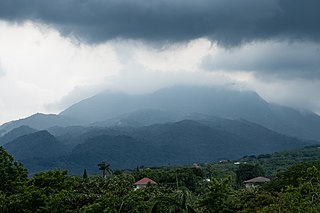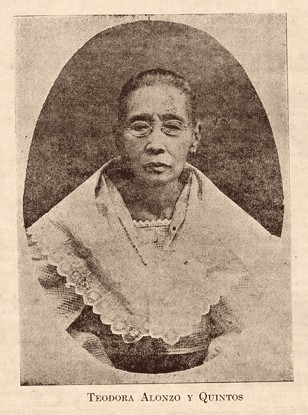
Laguna, officially the Province of Laguna, is a province in the Philippines located in the Calabarzon region in Luzon. Its capital is Santa Cruz while its largest city is the City of Calamba and the province is situated southeast of Metro Manila, south of the province of Rizal, west of Quezon, north of Batangas and east of Cavite. Laguna hugs the southern shores of Laguna de Bay, the largest lake in the country. As of the 2020 census, the total population of Laguna is 3,382,193. Among all 82 provinces in the Philippines, Laguna accounted for the largest share (5%) of the national Gross Domestic Product (GDP) with a total of Php 990.69 billion in 2022.

Calabarzon, sometimes referred to as Southern Tagalog and designated as Region IV‑A, is an administrative region in the Philippines. The region comprises five provinces: Batangas, Cavite, Laguna, Quezon, and Rizal; and one highly urbanized city, Lucena. It is the most populous region in the Philippines, according to the Philippine Statistics Authority (PSA), having over 16.1 million inhabitants in 2020, and is also the country's second most densely populated after the National Capital Region. It is situated southeast of Metro Manila, and is bordered by Manila Bay and South China Sea to the west, Lamon Bay and the Bicol Region to the east, Tayabas Bay and the Sibuyan Sea to the south, and Central Luzon to the north. It is home to places like Mount Makiling near Los Baños, Laguna, and Taal Volcano in Batangas. Calamba is the regional center while Antipolo is the most populous city in the region.

Southern Tagalog, designated as Region IV, was an administrative region in the Philippines that comprised the current regions of Calabarzon and Mimaropa, the province of Aurora in Central Luzon, and most of the National Capital Region. It was the largest region in the Philippines in terms of both land area and population. After its partition on May 17, 2002, Southern Tagalog continues to exist as a cultural-geographical region.

Los Baños, officially the Municipality of Los Baños, colloquialy 'elbi' or simply LB, is a 1st class municipality in the province of Laguna, Philippines. According to the 2020 census, it has a population of 115,353 people.

Calamba, officially the City of Calamba, is a 1st class component city in the province of Laguna, Philippines. According to the 2020 census, it has a population of 539,671 people making it the largest city in the province.

The South Luzon Expressway (SLEX), signed as E2 of the Philippine expressway network and R-3 of the Metro Manila arterial road network, is a controlled-access highway that connects Metro Manila to the provinces in the Calabarzon, Mimaropa and Bicol Region on the island of Luzon in the Philippines. The expressway has a length of 49.56 km, traveling from its northern terminus at the Magallanes Interchange in Makati to its southern terminus at Santo Tomas, Batangas, connecting it to the Southern Tagalog Arterial Road. A portion of the expressway from the Magallanes Interchange to the Calamba Exit is part of Asian Highway 26 of the Asian highway network. It will be the longest expressway in the Philippines starting with the completion of Toll Road 4 surpassing the Subic–Clark–Tarlac Expressway (SCTEX) as well as providing a gateway to Visayas upon the completion of Toll Road 5.

Bay, officially the Municipality of Bay, and colloquially known as Bae, is a 2nd class municipality in the province of Laguna, Philippines. According to the 2020 census, it has a population of 67,182 people.

Biñan, officially the City of Biñan, is a 1st class component city in the province of Laguna, Philippines. According to the 2020 census, it has a population of 407,437 people.

Rizal Day is a Philippine national holiday commemorating life and works of José Rizal, a national hero of the Philippines. It is celebrated every December 30, the anniversary of Rizal's 1896 execution at Bagumbayan in Manila.

Cabuyao, officially the City of Cabuyao, is a 1st class component city in the province of Laguna, Philippines. According to the 2020 census, it has a population of 355,330 people.

Paciano Rizal Mercado y Alonso Realonda was a Filipino general and revolutionary, and the older brother of José Rizal, the national hero of the Philippines.

José Protasio Rizal Mercado y Alonso Realonda was a Filipino nationalist, writer and polymath active at the end of the Spanish colonial period of the Philippines. He is considered a national hero of the Philippines. An ophthalmologist by profession, Rizal became a writer and a key member of the Filipino Propaganda Movement, which advocated political reforms for the colony under Spain.

The Rizal Shrine in Calamba is a reproduction of the original two-story, Spanish-colonial style house in Calamba, Laguna where José Rizal was born on June 19, 1861. Rizal is regarded as one of the greatest national heroes of the Philippines.

Saint John the Baptist Parish Church, commonly known as Calamba Church, is the oldest Roman Catholic church in Calamba, Laguna, Philippines under the Diocese of San Pablo. It is located adjacent to Rizal Shrine and is known as the christening site of José Rizal.

The Rizal Monument in Calamba is a monument built to commemorate the sesquicentennial (150th) birth anniversary of Dr. José Rizal, the Philippines' unofficial national hero and the greatest son of Calamba. It is a 6.7 metres (22 ft) statue sculpted by Jonas Roces and is located at The Plaza, a 6.7-hectare (17-acre) park in front of the Calamba City Hall Complex along Bacnotan Road in the barangay of Real. President Benigno Aquino III led the unveiling of the monument on June 19, 2011. The monument was cited as the tallest Rizal monument in the world before former Laguna Governor Jeorge 'E.R.' Ejercito Estregan inaugurated a 26 feet bronze Rizal Monument sculpted by Toym Imao, son of National Artist for Sculpture Abdulmari Asia Imao in Santa Cruz, Laguna, for the 2014 Palarong Pambansa hosted by the province.

Emilio Ramon Pelayo Ejercito III, commonly known as E. R. Ejercito, is a Filipino actor and former governor of Laguna from 2010 until his removal in 2014. Prior to his election as governor, he served as mayor of Pagsanjan, Laguna, from 2001 until 2010. He is the son of actor George Estregan and the nephew of former President and former Manila Mayor Joseph Estrada.

Teodora Alonso Realonda y Quintos was a wealthy woman in the Spanish colonial Philippines. She was best known as the mother of the Philippines' national hero Jose Rizal. Realonda was born in Santa Cruz, Manila. She was also known for being a disciplinarian and hard-working mother. Her medical condition inspired Rizal to take up medicine.

The Calamba City Hall, officially the City Hall of Calamba is located in the plaza of Calamba, Laguna in the Philippines. It is where the mayor of the city holds office and the chambers in the Calamba City Council., The old Calamba City Hall was located near the St. John the Baptist Parish Church and the Calamba Claypot which is the current site of City College of Calamba.



















